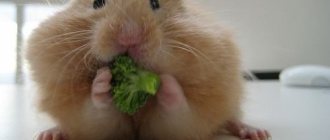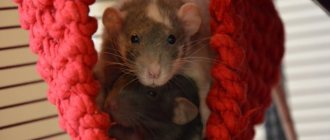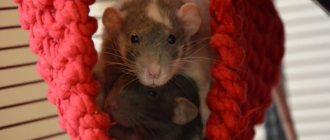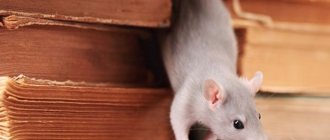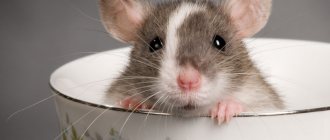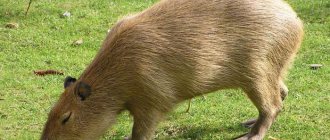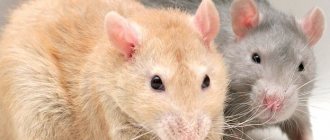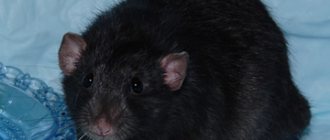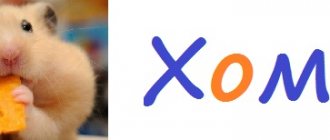Nobody knows when people first became acquainted with rats; this animal always lives next to us.
The rat belongs to the mammals, to the order - rodents, suborder - mouse-like. The most common animal on the planet is the rat.
Description of the rodent
— Advertising —
The body length of the rat is from 8 to 30 cm, the length of the tail is either the same as the body length or exceeds it, weight depending on the species is from 40 to 400 g. The body color is predominantly dark gray or gray-brown, yellow is also found , red and orange tones. The toes are very flexible.
Natural enemies
Rats try to avoid “communication” with representatives of canines and cats, as well as snakes and snakes. Their real enemies are: kites, eagles, owls. If foxes or beavers live in the region where rats live, a real war begins between them and the rodents.
In India, mongooses actively fight toothy pests. Some countries of the world (Japan, Colombia, New Zealand) periodically experienced an overabundance of breeding rats, threatening to destroy the entire harvest. In such cases, cats always came to the rescue, which were specially brought into the country to establish biological balance.
Rat nutritional features
Rats are omnivores, but each species has its own preferences. Some people eat more plant foods, seeds, vegetables, and fruits. Others prefer insects, mollusks, and small invertebrates. For example, the diet of a gray rat always contains animal protein, fish and amphibians, mollusks, small rodents and insectivores. From plant foods, rats feed on seeds, grains, and succulent parts of plants. Near a person they find all available food products, waste, livestock and poultry feed. There are practically no stocks.
A rat consumes 20-25 g of food per day, and 7-10 kg of food per year. Rats endure hunger very hard; without food they die on the 3-4th day. They die even faster in the absence of water. A rat usually drinks 30-35 ml of water per day, 5-10 ml if wet food is available.
Use as pets
Thanks to their natural intelligence, rats are easy to train. Most often, gray rodents become pets.
Caring for rats is not difficult. The animals are friendly and clean, but when feeding your pets you should follow moderation and listen to the advice of specialists and a veterinarian.
Important! Such rodents should not be kept alone. These animals are accustomed to living collectively; they feel good only in the company of their relatives.
Common types of rat
Gray rat, or pasyuk (Rattus norvegicus)
Body length without tail is 17-25 cm, weight 140-390 g. The tail is shorter than the body, up to 19.5 cm in length. The muzzle is blunt and wide, the ears are small. The color is gray with red in adults. The hair on the abdomen is white with dark bases. Sometimes there are black individuals.
The species is distributed on all continents except Antarctica. Eastern Asia is considered the homeland of the gray rat, from where they passively settled mainly on sea vessels.
Tan Rat (Rattus adustus)
Endemic to the island of Engano, which is located 100 km southwest of Sumatra (Indonesia). Outwardly it resembles a gray rat, but is more red in color.
Kinabuli rat (Rattus baluensis)
The species is found in Malaysia in northern Borneo at altitudes of 1524-3810 m above sea level. Lives in mountain and moss forests. Outwardly similar to a gray rat.
Black rat (Rattus rattus)
Smaller in size than the gray rat. Body length is 15-22 cm, weight 132-300 g. The tail is covered with dense hairs, longer than the body. The muzzle is narrow, the ears are large and round in shape. There are two color options:
- dark or black-brown above with a greenish tint of guard hairs; light sides; ashy or dirty gray tummy;
- on top the color is like that of a gray rat, but lighter and yellower, the tummy is whitish or yellowish.
Southern forms are usually larger and lighter in color than northern ones.
The species is cosmopolitan, distributed in Europe, Asia, Africa, America, and Australia.
Australian swamp rat (Rattus lutreolus)
Body length 12-20 cm, tail length 56-150 mm, weight about 115 g. The coat is gray-brown or dark gray on top, the belly is usually lighter, from brown to cream color. The hairs have golden tips. The ears are small and invisible in the fur. The tail is scaly with sparse hairs.
The species is found southeast of Fraser Island and south to Kangaroo Island, Tasmania, Bass Strait Islands, Queensland, up to 1600 m above sea level.
Long-haired rat (Rattus villosissimus)
Endemic to central and northern Australia, where it lives in arid or desert areas. Outwardly similar to a black rat.
Small rat (Rattus exulans)
The body is short, the muzzle is pointed, the ears are large, the color is brown. Body length is from 11.5 to 15 cm (without tail), the tail is thin, with “rings” on the surface. The length of the tail is equal to the length of the body. Weight is 40-80 g.
This is the third most common species of rat in the world. Indonesia is recognized as its homeland, from where the small rat was distributed throughout Southeast Asia and Oceania. Lives in steppes, fields and forests. Kept as a pet.
Other breeds
Through the process of crossing different species, many different breeds were developed. Some of them are not officially recognized because they are considered abnormal.
- Rex. The fur of this species of rat is curly and stiff. It seems to be sticking out in different directions. These animals have short, curling whiskers.
- Double rex. This variety has a striking distinctive feature, as it is susceptible to molting. Because of this, areas of curly hair alternate with bald spots. When hair grows on bald areas, it begins to fall out on those that had vegetation. These rats are not officially recognized.
- The breed of long-haired rats is otherwise called satin. Such animals do not differ in size from standard rats, but their fur is slightly elongated and very shiny.
- Husky. This species resembles a dog breed of the same name. On the animal’s muzzle there is a white mask of the same shape as that of dogs of this breed. They have the amazing feature of changing the color of their coat throughout their lives (colored wool is eventually replaced by white hairs).
Husky breed - Curly rats resemble lambs in appearance. They have a velvety, shiny and curly coat. On their bellies it can be either regular or curly.
- Wavy. These animals have thick, soft, fluffy and wavy fur.
- Odd-eyed. This is the most unusual type of rodent. The eyes of its representatives have different colors.
Rats are smart, beautiful, flexible and plastic animals. They are loved and bred by many. These rodents have helped humanity many times. For example, with their help, many drugs have been developed that save human lives. However, children and many adults love them simply for what they are, because they are quite cute and friendly. Now you have become acquainted with all types and breeds of decorative rats. It's time to go buy a pet!
Great article 23
Rat behavior
Rats lead a terrestrial or semi-arboreal lifestyle. In order to hide, they use burrows, which they dig themselves or by finding abandoned empty burrows of other animals. They live either alone or in family or territorial groups. There are up to several hundred or thousands of individuals in colonies. There is a hierarchy within the group. The colony occupies an area of up to 2000 m2, and marks it with scent marks.
Rats are active at night and at dusk. They often settle next to a person and easily adapt to his activity.
Lifestyle
Rats are the most common animal in the world. They are not found only in the Arctic and Antarctica. These rodents are characterized by group living, with hundreds of individuals in one family. The community is controlled by an alpha male and 2-3 females. Each group of animals controls a territory of up to 2000 sq.m.
Rat families have specific habitats. Most animals prefer to stay close to humans, feeding on leftover food or supplies taken from storage.
Rat breeding
They breed throughout the year, except in northern populations. The gray rat has 2-22 cubs in one litter, on average 8-9, in Malayan species from 3 to 6, in Australian species from 3 to 14
Under natural conditions, rats breed in warm weather, 2-3 times a year, and in heated rooms - all year round, breeding up to 8 offspring. The breeding cycle has a spring and autumn peak.
Pregnancy lasts 22-24 days. Babies weigh 4-6 g and are born naked, blind, with closed ear canals. Stillborn and weak rat pups are eaten by females. Males do not take part in raising offspring. The eyes of rat pups open 2 weeks after birth. At the age of 3-4 weeks they become independent. Females reach sexual maturity at 3-4 months.
The lifespan of rats in nature is from 1.5 to 3 years.
Cell selection
In order for your pet to feel great, you need to purchase a spacious cage with a set of all the necessary accessories and balanced food. You should always remember that the cage for a fluffy rat plays a very important role, since he spends most of his life in it. Therefore, when choosing a cage, you should be guided by the following requirements.
Cage dimensions
It is not recommended to keep your pet in a cramped cage, as the animal likes to move a lot. As a rule, the optimal cage dimensions are within the following limits: cage width – 40 cm, cage length – 60 cm and cage height – also 60 cm. For such an animal, this space is absolutely enough. The distance between the cage bars should be no more than 1.2 cm.
bottom of the cage
For such rodents, a solid floor is more suitable, since a lattice floor leads to injuries to the rodents’ limbs.
Cage tray
The starting material for the pallet is durable plastic. The pallet should have high sides to prevent the filler from spilling out. The pallet should not be made of wood, since wood will absorb urine, which will cause an unpleasant odor in the home.
Cage design
The best option is a collapsible cage with large doors to make it convenient to clean, wash, feed and hang various elements. The cage must have shelves for animals to rest.
Cage coating
As a rule, cage rods are coated with enamel, zinc or powder paint, which is not critical. The main thing is that the coating is of high quality, without chips or rust.
Interesting facts about the rodent:
- Rats cause economic damage as they eat and spoil food and non-food products, damage electrical networks, and cause damage to agriculture. In addition, they are a natural reservoir for many zoonotic and anthropozoonotic infections (plague, tularemia, rabies, typhus, toxoplasmosis, leptospirosis, rickettsiosis). Therefore, many methods have been developed for their destruction - deratization. But rats can adapt to and recognize poisons.
- In the United States, rats bite about 14,000 people every year.
- Since the 19th century, specially bred rats have been kept as pets. They are also bred as “live food” for home terrariums and zoos.
- Rats are the main experimental system in biological and medical experiments. Special laboratory rats were bred for this purpose. They are distinguished by their fast metabolism, unpretentiousness and peaceful nature.
- Rats are considered very intelligent animals; along with humans, they have abstract thinking. In addition, they respond to tickling and produce ultrasonic laughter-like sounds.
- In China, the rat is a symbol of prosperity and the first animal to open the cycle of the eastern horoscope. In Islam, the rat is the embodiment of sensuality, and Hinduism represents the rat as a former demon.
Benefits and harms
Rats are a vital link in every ecosystem. A striking example of this is the role of rodents in the “plant-mushroom” symbiosis. Rodents carry spores, ensuring their “meeting” with the necessary representatives of the flora.
Predatory animals and birds feed on rats. People use large rodents for scientific experiments. Decorative varieties of rats are bred for the purpose of domestication. They are often used in various educational projects and circus shows.
Rats are a necessary part of wildlife. An increase in population affects all elements of the ecosystem. The damage caused by rodents to people is enormous:
- damaged house walls and sewer pipes;
- damaged electrical wiring;
- poisoned crops;
- loss of part of the harvest harvested in storage;
- infection with infections (plague, salmonellosis, leptospirosis, pseudotuberculosis, etc.).
Wild rodents can cause significant damage to an orchard. They move freely through trees, damage the bark, and cause damage to shoots and fruits. Particularly dangerous are gray pasyuki, which have a rare appetite and aggressive character.
Body structure
Experts say that street rats have the ability to adapt and survive in almost any environment. But despite all this, they have very poor eyesight. This is explained by the structure of the lens. The structure of the lens makes it possible to see everything that surrounds it at an angle of 16º. To see much more, the rat is forced to constantly turn its head. They see almost everything that surrounds them in gray. They also have the ability to see the bluish-green part of the light spectrum. In red they see complete darkness.
Rats have very well developed senses of smell. Despite this, animals are not able to use this feature over long distances. This characteristic of the organism can be explained by the fact that evolution and natural selection determined it this way. The life of these animals occurs in such conditions that they simply do not need to have a higher sense. Despite this, at short distances, rats are very good at distinguishing all odors. They constantly examine each other using their sense of smell to understand who is nearby - their own or someone else's.
There are different types of rats
A certain feature is observed in the structure of the hearing organs. Rats can hear sounds even at frequencies around 40,000 Hz. Animals react very quickly even to the quietest noises. A very interesting fact is that pure sounds are not perceived by their ears at all.
Communication occurs with the help of a characteristic squeak. Rats have the best developed sense of touch. This has been confirmed through special studies. Special vibrissae act as organs of touch - these are small sensitive hairs. There are a lot of these hairs on the face.
Rodents have a very clear understanding of the tastes of food. In this respect they are not at all different from other existing species of mammals. The ability to distinguish taste is explained by the presence of small filiform papillae on the surface of the tongue. At the top they are covered with a special keratinized epithelium. This makes it possible to better retain food in the mouth. Rats have very well developed salivary glands, and the parotid, submandibular and sublingual glands are considered the most developed. The functioning of these glands ensures the production of saliva in the oral cavity, which is necessary for digesting food and wetting dust particles. Rodents need to wet the dust with saliva when they are setting up their home, or rather digging a hole.
These rodents have very strong teeth
For information
Rats belong to the class of mammals, more precisely, to the order of rodents and the family of mice. These rodents can be found in almost every corner of the planet. They even exist on islands that are very far from the mainland. The rat is the largest rodent of the mouse family, but they have significant differences in the anatomical structure of the body. They have an elongated body, a sharp muzzle, voluminous eyes and ears, and sparse hairs on their scaly tail. The skull consists of 6 unpaired and 11 paired bones. It is also divided into two sections: facial and cerebral.
By detecting a rat in a timely manner, you can take effective measures to combat them, which will help avoid the negative consequences of living together
Wool standardization
In contrast to the numerous markings, there are not many types of wool at all, and they have long been standardized. “Standard” by its name makes it clear that this type of wool is the most common. It is smooth and looks like gloss. Those animals whose fur is stiffer, denser and coarser are classified as “curly” hair type; all their hair and even their mustache curls.
There is also a “wavy” type, which differs from “curly” only in having softer hair. “Satin” is a type of wool that is more shiny and fine.
In the 2000s, long-haired rats also appeared; they have slightly larger fur than standard ones. There are few other species; rather, they are determined by the absence of hair. Therefore, hairless rats are only decorative and were bred quite recently.
Structure of teeth
Teeth are perhaps one of the most distinctive features of a rat, preventing it from being confused with a mouse.
Both the lower and upper jaws have two long incisors. In their sharpening, cutters are very similar to a chisel. On their front side there is very durable enamel. There is no enamel on the back side, and therefore they are constantly worn away, taking on the shape of a chisel. In the oral cavity of these rodents there is a diastema, which is a gap in the jaws in which teeth are completely absent. These voids are located between the incisors and molars. Incisors do not have a root system, which is why they grow continuously. This feature of the teeth completely answers the question of why rats constantly chew something. The thing is that the incisors grow continuously and if they are not ground down, they will grow so much that the rodent will not be able to fully close its mouth.
When living in a natural environment, that is, in nature, rats use their incisors to gnaw through various roots, branches and plants
There are different varieties of rats, and if we take into account the domestic type, they need to constantly put hard objects in the cage with which they can grind down their incisors. These rodents have very strong teeth. This is confirmed by the fact that they can cope with hard materials such as cement, wood, stone and some types of steel. When living in a natural environment, that is, in nature, rats use their incisors to gnaw through various roots, branches and plants.
As for the molars, they are located very close to each other and form an entire row. Their main task is to grind food. These teeth have a characteristic flat and slightly cusped surface.
How often should deratization be carried out?
Deratization should be carried out as needed, that is, at the first, even indirect, signs of the appearance of rats in the room. Evidence of rodents visiting the site can be their excrement, teeth marks on various surfaces, scattered food, bits of food and other evidence left by the “raiders” at the crime scene. However, according to the law of the Russian Federation, there are a number of social facilities where it is necessary to carry out rat control once a month for preventive purposes in order to eliminate the possibility of rats appearing. Proactive action should be taken in all facilities where food is stored, processed, packaged or prepared. Such objects include:
- Public catering points;
- Enterprises producing or processing products;
- Kindergartens;
- Schools;
- Sanatoriums and holiday homes;
- Hospitals;
- Nursing home;
- Terminals and storage;
- And other similar objects;
Organizations carrying out pest control
Since rats are a scourge throughout the country, the issue of their destruction is decided at the state level. There is even a law of the Russian Federation obliging the heads of administrations of all settlements and all legal entities to engage in pest control in the territory under their jurisdiction. This does not mean that they themselves must destroy all the rats - their task is to ensure the result by hiring professionals in the field of pest control. The direct performers of this work at the moment are exclusively private companies that provide disinsection, disinfection and deratization services to both individuals and legal entities. In socialist Russia, this function was performed by state sanitary and epidemiological stations, but now they are entrusted only with the tasks of supervision, control and scientific research. Entrusting the direct extermination of rats to private companies was a strategically correct decision - in a competitive environment, each performer strives for quality and gives a guarantee for his work. In addition, small companies are able to quickly resolve all issues without bureaucracy and additional approvals. They themselves purchase drugs, equipment and personal protective equipment, ensure the timely replenishment of all resources for successful and uninterrupted work, which clumsy government structures financed by the state budget cannot boast of. The best companies are always those that have entered this market a long time ago and intend to work in this area seriously and for a long time. They have many years of experience, knowledge and a whole arsenal of necessary means for exterminating rats. A striking example of such a successful company is the SES-24 company.
Rat head
The head of a rodent has the following features:
- quite large in size;
- elongated shape;
- pointed nose;
- rounded miniature ears;
- small eyes.
The rat's head has two parts - front and back. It is separated from the rat's body by the neck. The rodent's ears are shaped like a movable shell. The auditory canal runs through its base along the temporal bone.

